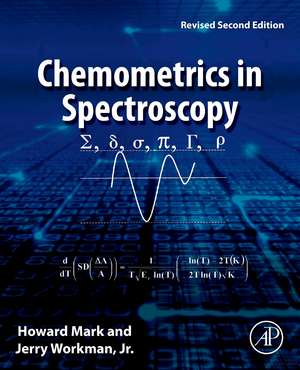Chemometrics in Spectroscopy: Revised Second Edition
Autor Howard Mark, Jerry Workman Jr.en Limba Engleză Paperback – 30 sep 2021
This revised second edition has been expanded with 50% more content on advances in the field that have occurred in the last 10 years, including calibration transfer, units of measure in spectroscopy, principal components, clinical data reporting, classical least squares, regression models, spectral transfer, and more.
- Written in the column format of the authors’ online magazine
- Presents topical and important chapters for those involved in analysis work, both research and routine
- Focuses on practical issues in the implementation of chemometrics for NIR Spectroscopy
- Includes a companion website with 350 additional color figures that illustrate CLS concepts
| Toate formatele și edițiile | Preț | Express |
|---|---|---|
| Paperback (2) | 1352.83 lei 5-7 săpt. | |
| ELSEVIER SCIENCE – 30 sep 2021 | 1352.83 lei 5-7 săpt. | |
| ELSEVIER SCIENCE – 11 iul 2018 | 1381.29 lei 5-7 săpt. |
Preț: 1352.83 lei
Preț vechi: 1760.66 lei
-23% Nou
Puncte Express: 2029
Preț estimativ în valută:
258.89€ • 268.65$ • 216.39£
258.89€ • 268.65$ • 216.39£
Carte tipărită la comandă
Livrare economică 08-22 martie
Preluare comenzi: 021 569.72.76
Specificații
ISBN-13: 9780323911641
ISBN-10: 0323911641
Pagini: 1092
Dimensiuni: 191 x 235 mm
Greutate: 1.83 kg
Ediția:2
Editura: ELSEVIER SCIENCE
ISBN-10: 0323911641
Pagini: 1092
Dimensiuni: 191 x 235 mm
Greutate: 1.83 kg
Ediția:2
Editura: ELSEVIER SCIENCE
Public țintă
Academic and industrial chemists who use NIR spectroscopy in their work; scientists in virtually every field of chemical endeavour, as well as in medicine, biochemistry, food analysis, clothing and related industries, petrochemicals, and moreCuprins
Section 1. Elementary Matrix Algebra
Section 2. Matrix Algebra and Multiple Linear Regression
Section 3. Experimental Designs
Section 4. Analytic Geometry
Section 5. Regression Techniques
Section 6. Linearity in Calibration
Section 7. Collaborative Laboratory Studies
Section 8. Analysis of Noise
Section 9. Derivatives
Section 10. Goodness of Fit Statistics
Section 11. More About Linearity in Calibration
Section 12. Connecting Chemometrics to Statistics
Section 13. Limitations in Analytical Accuracy
Section 14. Derivations of Principal Components
Section 15. Clinical Data Reporting
Section 16. Classical Least Squares (CLS)
Section 17. Transfer of Calibrations
Section 18. The Importance of Units of Measure
Section 19. The Best Calibration Model
Section 20. Statistics
Section 21. Outliers
Section 22. Spectral Transfer: Making Instruments Agree
Section 23. Applying Standard Reference Materials
Section 24. More About CLS
Section 2. Matrix Algebra and Multiple Linear Regression
Section 3. Experimental Designs
Section 4. Analytic Geometry
Section 5. Regression Techniques
Section 6. Linearity in Calibration
Section 7. Collaborative Laboratory Studies
Section 8. Analysis of Noise
Section 9. Derivatives
Section 10. Goodness of Fit Statistics
Section 11. More About Linearity in Calibration
Section 12. Connecting Chemometrics to Statistics
Section 13. Limitations in Analytical Accuracy
Section 14. Derivations of Principal Components
Section 15. Clinical Data Reporting
Section 16. Classical Least Squares (CLS)
Section 17. Transfer of Calibrations
Section 18. The Importance of Units of Measure
Section 19. The Best Calibration Model
Section 20. Statistics
Section 21. Outliers
Section 22. Spectral Transfer: Making Instruments Agree
Section 23. Applying Standard Reference Materials
Section 24. More About CLS
